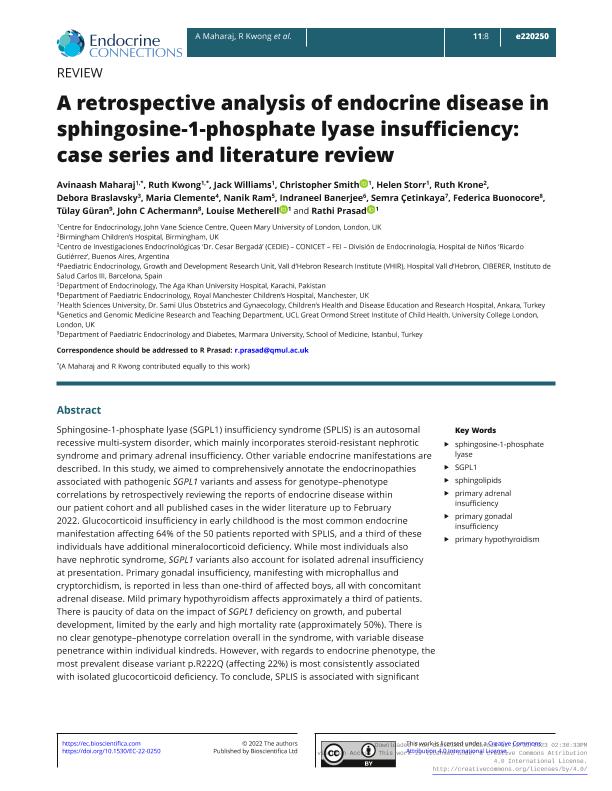Mostrar el registro sencillo del ítem
dc.contributor.author
Maharaj, Avinaash
dc.contributor.author
Kwong, Ruth
dc.contributor.author
Williams, Jack
dc.contributor.author
Smith, Christopher
dc.contributor.author
Storr, Helen
dc.contributor.author
Krone, Ruth
dc.contributor.author
Braslavsky, Debora Giselle

dc.contributor.author
Clemente, Maria
dc.contributor.author
Ram, Nanik
dc.contributor.author
Banerjee, Indraneel
dc.contributor.author
Çetinkaya, Semra
dc.contributor.author
Buonocore, Federica
dc.contributor.author
Güran, Tülay
dc.contributor.author
Achermann, John C.
dc.contributor.author
Metherell, Louise
dc.contributor.author
Prasad, Rathi
dc.date.available
2023-10-31T14:52:42Z
dc.date.issued
2022-07
dc.identifier.citation
Maharaj, Avinaash; Kwong, Ruth; Williams, Jack; Smith, Christopher; Storr, Helen; et al.; A retrospective analysis of endocrine disease in sphingosine-1-phosphate lyase insufficiency: case series and literature review; BioScientifica; Endocrine Connections; 11; 8; 7-2022; 1-13
dc.identifier.uri
http://hdl.handle.net/11336/216629
dc.description.abstract
Sphingosine-1-phosphate lyase (SGPL1) insufficiency syndrome (SPLIS) is an autosomal recessive multi-system disorder, which mainly incorporates steroid-resistant nephrotic syndrome and primary adrenal insufficiency. Other variable endocrine manifestations are described. In this study, we aimed to comprehensively annotate the endocrinopathies associated with pathogenic SGPL1 variants and assess for genotype–phenotype correlations by retrospectively reviewing the reports of endocrine disease within our patient cohort and all published cases in the wider literature up to February 2022. Glucocorticoid insufficiency in early childhood is the most common endocrine manifestation affecting 64% of the 50 patients reported with SPLIS, and a third of these individuals have additional mineralocorticoid deficiency. While most individuals also have nephrotic syndrome, SGPL1 variants also account for isolated adrenal insufficiency at presentation. Primary gonadal insufficiency, manifesting with microphallus and cryptorchidism, is reported in less than one-third of affected boys, all with concomitant adrenal disease. Mild primary hypothyroidism affects approximately a third of patients. There is paucity of data on the impact of SGPL1 deficiency on growth, and pubertal development, limited by the early and high mortality rate (approximately 50%). There is no clear genotype–phenotype correlation overall in the syndrome, with variable disease penetrance within individual kindreds. However, with regards to endocrine phenotype, the most prevalent disease variant p.R222Q (affecting 22%) is most consistently associated with isolated glucocorticoid deficiency. To conclude, SPLIS is associated with significant multiple endocrine disorders. While endocrinopathy in the syndrome generally presents in infancy, late-onset disease also occurs. Screening for these is therefore warranted both at diagnosis and through follow-up.
dc.format
application/pdf
dc.language.iso
eng
dc.publisher
BioScientifica

dc.rights
info:eu-repo/semantics/openAccess
dc.rights.uri
https://creativecommons.org/licenses/by/2.5/ar/
dc.subject
PRIMARY ADRENAL INSUFFICIENCY
dc.subject
PRIMARY GONADAL INSUFFICIENCY
dc.subject
PRIMARY HYPOTHYROIDISM
dc.subject
SGPL1
dc.subject
SPHINGOLIPIDS
dc.subject
SPHINGOSINE-1-PHOSPHATE LYASE
dc.subject.classification
Endocrinología y Metabolismo

dc.subject.classification
Medicina Clínica

dc.subject.classification
CIENCIAS MÉDICAS Y DE LA SALUD

dc.title
A retrospective analysis of endocrine disease in sphingosine-1-phosphate lyase insufficiency: case series and literature review
dc.type
info:eu-repo/semantics/article
dc.type
info:ar-repo/semantics/artículo
dc.type
info:eu-repo/semantics/publishedVersion
dc.date.updated
2023-10-30T16:14:04Z
dc.identifier.eissn
2049-3614
dc.journal.volume
11
dc.journal.number
8
dc.journal.pagination
1-13
dc.journal.pais
Reino Unido

dc.description.fil
Fil: Maharaj, Avinaash. Queen Mary University Of London; Reino Unido
dc.description.fil
Fil: Kwong, Ruth. Queen Mary University Of London; Reino Unido
dc.description.fil
Fil: Williams, Jack. Queen Mary University Of London; Reino Unido
dc.description.fil
Fil: Smith, Christopher. Queen Mary University Of London; Reino Unido
dc.description.fil
Fil: Storr, Helen. Queen Mary University Of London; Reino Unido
dc.description.fil
Fil: Krone, Ruth. Birmingham Children's Hospital; Reino Unido
dc.description.fil
Fil: Braslavsky, Debora Giselle. Consejo Nacional de Investigaciones Científicas y Técnicas. Oficina de Coordinación Administrativa Parque Centenario. Centro de Investigaciones Endocrinológicas "Dr. César Bergada". Gobierno de la Ciudad de Buenos Aires. Centro de Investigaciones Endocrinológicas "Dr. César Bergada". Fundación de Endocrinología Infantil. Centro de Investigaciones Endocrinológicas "Dr. César Bergada"; Argentina
dc.description.fil
Fil: Clemente, Maria. Instituto de Salud Carlos III; España
dc.description.fil
Fil: Ram, Nanik. The Aga Khan University Hospital; Pakistán
dc.description.fil
Fil: Banerjee, Indraneel. Royal Manchester Children's Hospital; Reino Unido
dc.description.fil
Fil: Çetinkaya, Semra. Children’s Health and Disease Education and Research Hospital; Turquía
dc.description.fil
Fil: Buonocore, Federica. University College London; Estados Unidos
dc.description.fil
Fil: Güran, Tülay. Marmara University; Turquía
dc.description.fil
Fil: Achermann, John C.. University College London; Estados Unidos
dc.description.fil
Fil: Metherell, Louise. Queen Mary University Of London; Reino Unido
dc.description.fil
Fil: Prasad, Rathi. Queen Mary University Of London; Reino Unido
dc.journal.title
Endocrine Connections
dc.relation.alternativeid
info:eu-repo/semantics/altIdentifier/url/https://ec.bioscientifica.com/view/journals/ec/11/8/EC-22-0250.xml
dc.relation.alternativeid
info:eu-repo/semantics/altIdentifier/doi/http://dx.doi.org/10.1530/EC-22-0250
Archivos asociados
